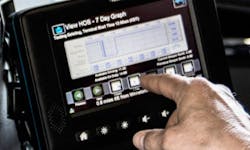As a surprise to probably no one, thousands of truckers oppose the impending imposition of the electronic logging device (ELD) mandate this December and they are working hard to either delay or scuttle it; primarily via Congressional legislation
The rants against ELDs, especially on social media, can get heated and incorporate plenty of profanity at times (something I can attest to where my Twitter feed is concerned).
Yet that anti-ELD "rage," for lack of a better term, can also obscure what are some fair criticisms being leveled at the mandate and at ELDs in particular – criticism that by and large hasn't been adequately addressed.
I talked with Les Willis the other day to get some insight into the business reasoning behind the still-widespread opposition of ELDs, especially among small fleets and owner-operators.
Interestingly, Willis – who's been in transportation since 1984 and operates a small fleet of seven Class 8 straight trucks that haul specialized cargo across the "Lower 48" region in the U.S. – told me that once a fleet grows in size to 10 trucks or more, it is actually “feasibly necessary” to adopt some level of fleet/freight management system into one’s business model.
By that he means ELDs for a larger fleet can often be a good idea.
“The back office inefficiencies created as a fleet grows must be overcome, so having ELDs or automatic onboard recording devices [AOBRDs] helps to drive efficiency within the company,” he explained.
But he also stressed that cost justifying such investments is hard for fleets operating six or fewer trucks, especially when “razor thin margins” are the norm among small fleets and one-truck owner-operators today.
“Over 91% of the over 500,000-plus registered carriers within the U.S fall within the range of six units or below, so this … mandate bleeds of the ignorance of Congress when it comes to daily trucking operations. You cannot have a one-size-fits-all-approach to … this industry.”
And despite his “situational support” for ELDs, Willis still deems them to be “ludicrous devices” in the main – largely because of the cost to install them and the view by some in the industry that they are an “end all, be all” replacement for paper logbooks.
He said that the cost of complying with the ELD mandate – estimated to be $1.5 billion for the industry as a whole – will largely fall on the backs of small trucking operators; the ones who can ill afford it.
The Federal Motor Carrier Safety Administration (FMCSA) estimates that the average annual cost of an ELD will be $495 per truck, with a total “cost range” of $165 to $832 per truck on an annualized basis. The agency also believes the truck industry will realize a “net benefit” of $1 billion through the elimination of paperwork and work time necessary for filling out, filing, and maintaining paper records.
Still, Willis contends the costs outweigh the benefits. “The smaller carriers will be responsible for $1.3 billion [of that $1.5 billion in cost] with larger carriers tasked with the remaining $200 million. Who are we really asking to fund this mandate? This level of funding will in essence strain the smaller fleets to the brink of non-existence,” Willis pointed out. “Certainly some will be able to survive, but there will be those who do not. Who picks up this market share and at what cost to the end user?"
Then there’s the implicit rebuke of paper logbooks by those supporting ELD usage.
“Why are paper logbooks being derided as an ‘inaccurate’ method of recording hours of service (HOS) data? Many other federal agencies continue to accept manually entered paper records,” he explained to me. “If manual entries can be submitted to the Internal Revenue Service when filing your 1040 form, why are manually entered logbooks not admissible any longer to the FMCSA?”
Then there’s a technological issue, according to Willis: requiring ELDs to be connected to truck engine control modules (ECMs).
“There is no need to connect an ELD to the ECM,” he stressed. “With the level of visibility generated by today’s telematics system, there is no need for such a connection.”
Added to that is FMCSA guidance regarding the "self-certification” of ELDs.
“Certainly ‘self-certify’ is an accepted practice [for] automotive components such as wheels and water pumps,” he said. “But that connected ELD may cost me to the tune of $4,000 to $5,000 if it compromises my ECM. That's a huge risk no one needs to take.”
Then there is the cost-benefit equation to consider, especially when it comes to safety.
While trucking is expected to pay $1.5 billion overall to comply with the ELD mandate, FMCSA only expects those devices to help save 26 lives and prevent 1,844 crashes involving large commercial motor vehicles annually.
“About 52 people each year die from wasp and bee stings,” Willis noted as a way to put those 26 lives saved in perspective. “The FMCSA projects 26 lives saved. To prevent those deaths, the trucking industry needs to spend $1.5 billion. Is this even fiscally responsible?”
He added that AOBRDs have been widely used for the last several years to electronically record logbook information, yet truck-related highway crash fatalities continue to rise.
For example, there were 4,317 fatalities in crashes involving large trucks in 2016 according to the National Highway Traffic Safety Association (NHTSA) – 5.4% more fatalities than in 2015 and the highest since 2007. “If ELDs are supposed to help improve safety, shouldn't we see a reduction instead of an increase?” Willis said.
Finally there's the argument regarding the creation of a "level playing field" in the industry by making all truck operators use ELDs.
“If we really wanted a level playing field, and if the ELD mandate was such a great leveling tool, why is FMCSA granting so many exemptions to the rule? UPS [United Parcel Service] gets an exemption; agricultural haulers get an exemption as well. If your truck engine is manufactured before 2000, you are exempt as well. This is a level playing field? Put the mandate in and make no one exempt from the rule. That is a level playing field.”
From his perspective, Willis believes if you really want to boost trucking safety with ELDs, and, by extension, improve HOS compliance, then government regulators should adopt the European model of a “smart card” system.
“This is a model that really is tied to HOS and RODS [record of duty status] in an electronic format,” he stressed. “This system is designed to distinguish which operator is at the controls of the unit. The driver has a smart card; the mechanic; the state trooper at a roadside inspection; the owner; even the yard hostler moving terminal tractors. Every one of them gets a different smart card [that is] directly tied to the occupational responsibilities they are asked to perform. They are not solely tied to the power unit as the current [ELD] models are. In short, you don't need an exemption; you need a better device.”
Willis emphasized to me that most small fleets and owner-operators are not against ELDs per se; what they really oppose is how the devices function and the blanket-style implementation of the rules regarding their usage.
“Let the marketplace work; it is the marketplace that will dictate the SOPs (standard operating procedures), [load] visibility, and service level requirements of a motor carrier,” he said. “It really is very simple; you either adjust to the market requirements or you go out of business.”
From his perspective, if a customer demands telematics usage and a trucking company cannot supply it they will lose that business to a competitor.
“You only have yourself to blame; but you do not need the federal government coming in and picking winners and losers with unfunded mandates,” Willis pointed out. “Let the FMCSA and states do their jobs and enforce the CSRs [carrier safety regulations] that are currently on the books and raise driver training standards. But you must give carriers a choice of [HOS] compliance, be it electronic or paper. The marketplace is what will dictate their survival.”
Good points worth making about ELDs and HOS compliance. That being said, though, it’s almost the 59th minute of the 11th hour where the imposition of the ELD mandate is concerned. Will those concerns trump the December 18 deadline? The chances seem slim, but we can only wait and see what ultimately happens.




